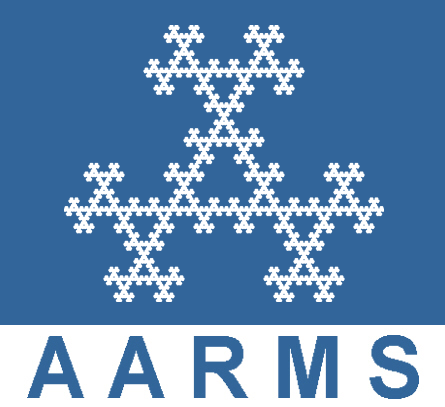2017 CMS Winter Meeting
Waterloo, December 8 - 11, 2017
- DOMINIQUE DUPONT-JILLINGS, McMaster University
Reduced Simplicial Homology and Circulant Graphs [PDF]
-
This poster introduces a family of circulant graphs that is Cohen-Macaulay. We begin by introducing simplicial complexes. We then define reduced simplicial homology and introduce the definition of Cohen-Macaulay simplicial complexes. These ideas are then applied to graphs to define Cohen-Macaulay graphs. We review the literature by describing what families of circulant graphs are known to be Cohen-Macaulay and we finish by introducing a new family of circulant graphs that are Cohen-Macaulay.
- FARINAZ FAROUZANNIA, f3forouz@uwaterloo.ca
The impact of tumour heterogeneity on the radiation treatment [PDF]
-
Radiation oncologists try to deliver the maximum amount of radiation to cancerous cells (while simultaneously minimizing energy delivered to adjacent normal tissues) in order to maximize cancer cell kill while preventing damage to the normal cells around the affected tissue. To achieve this goal, various treatment schedules have been developed, but there still remain significant obstacles to improving the effectiveness of these schedules. Recent studies have explained the existence of cellular diversity within tumors or during the different steps of tumor evolution such as, tumour heterogeneity. These genetic and non-genetic variations can lead to different radiosensitivity among cancer cells that can make treatment processes complicated. Thus, a model is proposed to study the effect of treatment on tumour heterogeneity and to investigate the repair impact on the treatment. The stochastic and deterministic simulations have been used to extrapolate the model's parameters using the experimental results. The sensitivity analysis is also applied to explore how changing a model's parameters alter the model's outcome in conventional radiotherapy protocols. The results suggest that shrinking the tumor is not sufficient to control the disease and fraction of resistant cells to the treatments is also need to be reduced. In addition, the optimal treatment schedules are not unique and changing model's parameter may change the best treatment schedules.
- RACHEL HARDEMAN, University of Calgary
Classical Homotopy Theory vs A-Homotopy Theory for Graphs [PDF]
-
In Algebraic Topology, two spaces are homotopic if you can continuously deform one space into the other. For example, the coffee mug and the doughnut are homotopic, because we can continuously deform the cup of the mug on to the handle until it is a doughnut. Thus these two shapes have the same homotopy groups, that is, the hole formed by the handle and the doughnut hole, respectively, represent the only non-trivial generators of the homotopy groups of these shapes. When considering a graph as a topological space, the graph is homotopic to a bouquet of loops and would only be contractible, that is, homotopic to a point, if the graph was acyclic. But a graph is more than the sum of its holes. Thus A-homotopy theory was developed as a way to find the invariants in a graph while respecting the combinatorial structure of the graph.
In this poster, I will introduce the basic definitions of A-homotopy theory, discuss the motivation for studying A-homotopy theory, and give examples of how classical homotopy theory differs from A-homotopy theory, including contractible graphs, fundamental groups of graphs, and the homotopy lifting property.
- FRANÇOIS LARIVIÈRE, Université de Montréal
Équations différentielles de Stieltjes [PDF]
-
La dérivée de Stieltjes a été introduite très récemment comme une nouvelle unification du calcul différentiel continu et discret. L'introduction de ce concept ouvre donc la porte à de nombreuses questions portant sur la théorie des équations différentielles faisant intervenir cette dérivée. Ma recherche est donc guidée par la volonté de généraliser les résultats déjà connus en équations différentielles classiques à ce nouveau type d'équations différentielles. Plus précisément, je travaille sur l'équivalent d'un lemme de Grönwall et l'existence d'un intervalle maximal d'existence pour les solutions.
- DARIAN MCLAREN, Brandon University
Perfect quantum state transfer on weighted paths [PDF]
-
A quantum spin chain is a proposed method for transferring a quantum state over small distances. We focus on perfect state transfer (PST) in which one particle is encoded with the desired state and after the spin chain evolves over some time the same state emerges in a different particle. In particular, we are interested in PST for the case in which the spin chain can be modeled by a weighted path (allowing for loops). We explore PST on these weighted paths using orthogonal polynomials.
- STEPHEN MELCZER, University of Pennsylvania
Effective Enumeration and Computer Algebra [PDF]
-
The field of analytic combinatorics studies the asymptotic behaviour of sequences through analytic properties of their generating functions. In addition to the now classical univariate theory, recent work in the study of analytic combinatorics in several variables (ACSV) has shown how to derive asymptotics for the coefficients of certain D-finite functions by representing them as diagonals of multivariate rational functions. This poster describes the rich theory of ACSV from a computer algebra viewpoint, highlighting the first fully rigorous algorithm and complexity results. Applications to combinatorics (lattice path enumeration) and number theory (asymptotics of binomial sums related to irrationality proofs) are discussed.
- JEMISA SADIKU, York /university
Modelling the impact of “resistance” on structured tick population dynamics [PDF]
-
The resistance, behavioral and immunological response, has been reported in the biological literature but its impact on tick population dynamics has not been mathematically formulated and analyzed. Here we develop and simulate a delay differential equation model, with a particular focus on this “resistance” phenomena. We calculate the basic reproduction number using the spectral analysis of delay differential equations with positive feedback, and establish the existence and uniqueness of a positive equilibrium when the basic reproduction number exceeds unit. We also conduct numerical and sensitivity analysis about the dependence of this positive equilibrium on the “resistance” rate.
- AARON SLOBODIN, Quest University Canada
Betti table stabilization of homogeneous monomial ideals [PDF]
-
Given an homogenous monomial ideal $I$, we provide a question and example based investigation on the stabilization patterns of the Betti tables shapes of $I^d$ as we vary $d$. We build off Whieldon's definition of the stabilization index of $I$, Stab$(I)$, to define the stabilization sequence of $I$, StabSeq$(I)$, and use it to explore changes in the shapes of the Betti tables of $I^d$ as we vary $d$. We also present the stabilization indexes and sequences of the collection of ideals $\{I_{n}\}$ where $I_{n}=(a^{2n}b^{2n}c^{2n},b^{4n}c^{2n},a^{3n}c^{3n},a^{6n-1}b)\subseteq \Bbbk [a,b,c]$.
- JINGJING XU, University of Western Ontario
A kin-selection model on persistence of altruism [PDF]
-
Persistence of altruism has been an engaging research area. In all types of altruism behaviors, cooperative breeding has captured a lot of attention. Using kin selection as a tool, we construct a comprehensive model to study the persistence condition of altruism. In our model, we classify individuals in the population of a species into four types, according to their role at the time we look at the population, i.e., floaters, helpers, solitary breeders, and breeders with a helper. We assume: i) the population is hermaphrodite, ii) breeders either have no helper or one helper each time, iii) the life cycle has the order -- birth, helper death, dispersal, adult death. We assume ‘helping gene’ can have control over the following phenotypes: helpers’ level of helping (helper can also react differently, when it is born to two types of breeders), the effect of their helping on the improvement of survival rate and fecundity rate of breeders with a helper, the decreasing of helpers’ own survival rate. We examine the rate of change of inclusive fitness with the genotype, and obtain conditions for persistence of altruism. We compare the conditions for different scenarios: i) helpers improve newborns’ survival rate only, ii) helpers improve breeders’ survival rate, as well as newborns’ survival rate, iii) helpers improve breeders’ fecundity through male function, in addition to the improvement of fecundity through natal female function.
- BORA YONGACOGLU, Queen's University
Using Reinforcement Learning to Solve a Decentralized Control Problem [PDF]
-
Reinforcement learning algorithms have been used to solve single agent Markov decision processes even when the agent does not have access to the transition probabilities or the cost function. The availability of feedback, in the form of short term cost realizations and one-step transition observations, allows the agent to learn the environment. We consider a generalization of this problem, in which there are multiple decision makers with the same interests but different local information. Learning in games is considerably more difficult than learning in a stationary environment, as the presence of other agents who are learning and changing their behaviour leads to unreliable feedback. We present an algorithm that converges to optimal behaviour.
- POLLY YU, University of Wisconsin - Madison
Generalized Polynomial Models of Biochemical Systems [PDF]
-
A common mathematical model of reaction networks, mass action kinetics, uses polynomials to model the concentrations of the chemical species involved in biochemical systems. More general models exist: e.g., Michaelis-Menten kinetics (with rational functions) and generalized mass action kinetics (with generalized polynomials or power-law functions). In any case, these highly non-linear systems can exhibit behaviours as tame as convergence to steady state, oscillation, and as wild as chaos. One of the goals is to draw conclusion about the dynamical system from information about the network alone, which consists of a directed graph and a map assigning a stoichiometry vector to each vertex. We provide a condition for when a generalized mass action system has a unique (vertex-balanced) steady state up to conservation law. In addition, we discuss how generalized mass action systems can be used to study mass action systems. (Joint work with Gheorghe Craciun, Stefan M\"uller, Casian Pantea.)
- BEHNOOSH ZAMANLOOY, Concordia University
Default Probability Estimation from Historical Data [PDF]
-
Over the last few years, different methods using the assumption of time homogeneity of rating transition matrices have been proposed. However, most of the methods do not use the actual information provided in the data, for example, time a firm spends in a rating, the tendency for a firms rating to drop, and etc. In my poster, I will address the well known methods (naive approaches and Baum-Welch learning) to estimate the credit rating transition probability matrix, as well as propose a particle filtering approach to incorporate time inhomogeneity and the tendency to go downwards into the estimation process.





